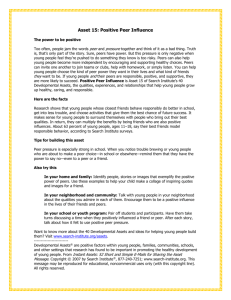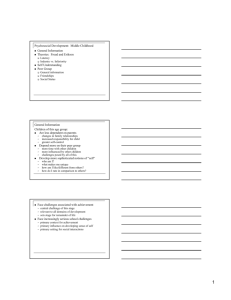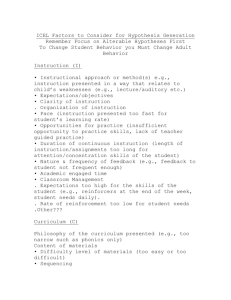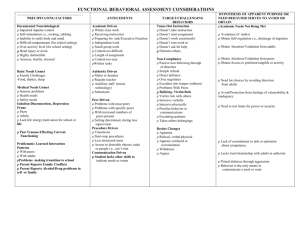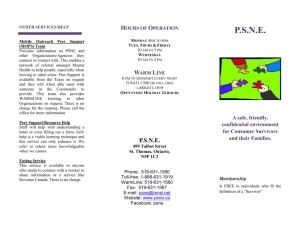Psychology 3260: Personality & Social Development
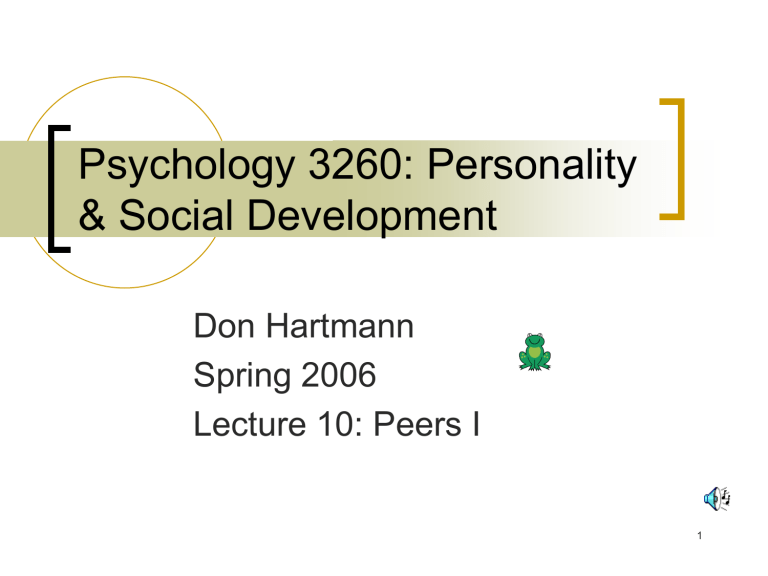
Psychology 3260: Personality
& Social Development
Don Hartmann
Spring 2006
Lecture 10: Peers I
1
Administration
The library has a Writing Center (in conjunction with the Writing Program) on Level 3 “to help students at all levels become better writers.”
(Phone # 587-9122 or just drop by the 3 rd floor of
Marriott in the Atrium area). Ben is your man.
If your group elected to write autobiographical papers, but a minority would like to present to the class, they are welcome to recruit from other groups. Please let me know who you are.
• Reed Dow
• Salem Honey
Quote of the Day: " Be who you are and say how you feel because those who mind don't matter and those who matter don't mind"----Dr. Seuss
2
WEB Discussion Topic #10
I. J. Skinner & the classroom. Bono.
Summary due Thursday, February 16th.
Assume that you are a elementary school teacher. You are intrigued with Skinner’s theory, and are attempting to integrate his theory into your teaching practices. What implications can you come up with from what you have learned about his theory?
Which of his principles are implicated in the potential applications you have noted?
3
WEB Discussion Topic #11
I.K. Bronfenbrenner & Skinner. Girlie.
Summary due Friday, February 17th.
While both Skinner and Bronfenbrenner
(who recently died) focus on the environment’s “control” over behavior, neither one would be comfortable being described as a follower of the other. How do their theories differ? How do their conceptions of the environment differ? As always, feel free to reply to the comments of others.
4
WEB Discussion Assignments
& Due Dates
WEB Assignment #
II III Group
CSI
Growing Pain
I
02/03
02/06
Psyched
Agrrrression
02/07
02/08
Authoritarians
Divas
Peer Pressure
02/09
02/10
02/13
Morally Distinguished 02/14
Raging Hormones 02/15
Bono 02/16
Girlie 02/19
IV
Note: Each discussion topic closes at 5:00 p.m. two days prior to the stated due data.
5
Panel Discussion Schedule
Wednesday…
Feb. 15 th
Feb. 22 nd Identity (Murquia et al.)
Feb. 29 th
Mar. 08 th
Mar. 15 th Bullying (Borski et al.)
Mar. 29 th
Apr. 05 nd : Family topic (Kyle et al.)
Apr. 12 th
Apr. 19 th
Get you time period now, they are going like hot cakes !
6
Handout Summary
Handout* WEB
11. Sup. Lect. #3: Method III
12. HO: Autobio. Term Paper
13. Lecture #4a: Method III
14. HO: Completed Class Locator
15. Sup. Lect: Term Paper
16. Code of Academic Conduct
17. Study Guide #2: Chpt. 2
18. Lect. #7: Skinner
19. Lect. #8: Bandura
20. Study Guide #3
21. Lect. #9: Piaget
22. Lect. 10: Peers I
23. Study Guide #4
Date
-----
-----
-----
-----
-----
-----
-----
-----
-----
01/13
-----
-----
-----
Date
01/11
01/11
01/12
-----
01/13
01/18
01/18
01/18
01/19
01/24
01/25
01/27
01/30
-----
*Handout date refers to the date the handout was distributed in class. WEB date indicates the date the handout should have been included on the class WEB site. A dashed line indicates that the handout either was not distributed in class or was not
7 placed on the WEB .
Study Guide Assistance from the Instructor
Based upon past experience, a number of you will wait until the night before the exam to prepare answers to the study guides. You should know the rules relating to requests to the instructor for help on the study guides:
I do not take class material home with me, so I am unlikely to be able to answer questions after 5:00 p.m. on the evening prior to the exam —or any other evening.
You are to use the instructor as a last resort after consulting with class mates about study guide answers.
The instructor will not answer more than 3 study guide questions per request and you are limited to 1 request per day.
8
Supplementary References:
Peers I
Rubin, K.H., Coplan, R.J., Chen, X., Buskirk, A.A.,
Wojslawowicz, J.C. (2005). Peer relations in childhood. In M.H. Bornstein & M.E. Lamb
(Eds.) Developmental science: An advanced
textbook (5 th ed.). Mahwah, NJ: Lawrence
Erlbaum.
Rubin, K. H., Bukowski, W., & Parker, J. G. (1998).
Peer interactions, relationships, and groups. In
W. Damon (Series Ed.) N. Eisenberg (Vol. Ed.),
Handbook of child psychology, Vol. 3: Social, emotional, and personality development (5th ed., pp. 619-700). New York: Wiley.
9
Overview of Peer
Relations I Lecture
Overlap with text, pp. 421-424 & 434-
437
Lecture
Who Are Peers?
Why Study Peers?
Historical Perspective
Scientific Investigations of the Peer Group:
Early Period
Next: Lecture 11: Peers II
10
Peers: Who are they?
In age-graded society, children within a year of age of one another; individuals of a similar level of behavioral complexity
However, wider age variation true of neighborhood social groups
11
Parental vs. Peer
Relationships
Parents
Hierarchical
Nurturance
Dependency
Peers
Equalitarian
Competition
Reciprocity
12
Ellis et al.: Neighborhood
Companions
13
What do children do with their peers? High Tech Method
Hi tech
(Csikszentmihalyi &
Larsen): Experience time sampling
14
What do children do with their peers? Low Tech Method
Diaries (Zarbatany et al. &
Hartmann et al.)
•10-14%: Hanging out, Team sports, &
Classroom activities
•5-9%: Recreational activities, individual sports, study/rehearsal, & eating
15
Who Cares? And Why?
Increasing evidence that peers are critical to our eventual adult functioning
Animal studies: Harlow's studies of peer deprived monkeys)
Longitudinal studies of children who have faulty peer relations, particularly those who are either aggressive or rejected (Parker & Asher, 1987
Psychological Bulletin review), indicates that these children are at risk for later problems.
Important for development of social control, social skills, and social values.
16
The Declining Influence of
Parents?
17
SCIENTIFIC INVESTIGATIONS
OF THE PEER GROUP
The early period
Early observational work (Ruth
Arrington at Yale); early studies of gangs
Work of Kurt Lewin
Moreno's work on sociometric techniques.
19
Sociometric Classifications
Negative Nominations
Many Few
Controversial Popular
Rejected Neglected
20
Assessing Popularity
Referred to as Sociometric Status (SMS)
Started with Moreno (of Psychodrama fame)
Participants asked two questions (nominations or ratings):
Who do you like?
Who do you dislike?
Then construct two dimensions
Like + Dislike = Social Impact
Like – Dislike = Social Preference
Individuals assigned to classification categories based upon their Social Impact and Social
Preference scores
21
Rejected Controversial
Is the child liked?
Popular
Low
Average
Social
Impact
Neglected
Average
Social Preference
High
22
The Results
Of the 60% who are classifiable (40% are “other”)
15% average
7.5% controversial
7.5% neglected
15% popular
15 rejected.
Peer-based classification agree with teacher ratings
Accurately predict the character of children’s peer interactions
Stability: Controversial least stable; rejected most stable.
23
What are they like?
Large number of observational, peer report, and self-report studies on children’s SMS
Rejected kids:
Rejected-aggressive: uncooperative, critical; little prosocial behavior. At greatest risk for future problems
Rejected-withdrawn: awkward, insensitive, and immature. Lonely with low self esteem
Popular: outgoing, friendly, supportive, and calm. Initiate interactions and resolve disputes amicably. Prosocial and not aggressive
Neglected: passive and shy. Don’t initiate and don’t call attention to self
Controversial: the jokesters; some evidence that controversial adolescent girls are more likely to have kids early
24
Summary of Social Cognition
Lecture
Lecture
Who Are Peers?
Why Study Peers?
Historical Perspective
Scientific Investigations of the Peer Group: Early Period
Next: Lecture #11: Peers II
Go in Peace
25
